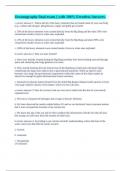Exam (elaborations)
Oceanography final exam || with 100% Errorless Answers.
- Course
- Institution
c correct answers 1. Where did all of the heavy elements that are found inside of your own body (e.g., carbon and nitrogen, phosphorous, copper and gold) get created? a. 50% of the heavy elements were created directly from the Big Bang and the other 50% were created later inside of stars or when...
[Show more]



